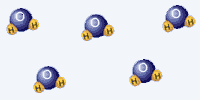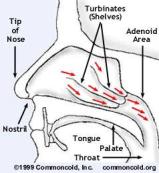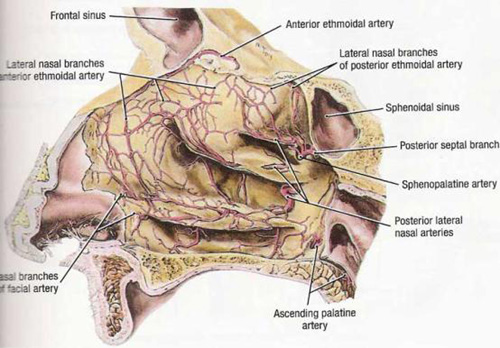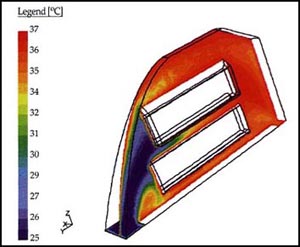The Main Roles of the Turbinates
- To direct and maintain laminar airflow, respiratory rate and velocity
- Air Conditioning (Humidification + Heating)
- Filtration
- Olfaction
(b) Heating
Another key factor in maintaining proper humidification, proper gas exchange, optimal cilia beat, good conditions for filtration, and waste disposal, is the temperature of the inspired air. It is the nose’s “job” to heat (or in very hot climates – cool) the inspired air to close proximity to body temperature. By doing that, it makes it easier for the lungs to function. Imagine if the lungs had to be constantly subjected to the outside air temperatures. Some temperatures can be so cold – that with no heating device the breathing would seize up. The nose achieves this energy consuming task of heating, mostly thanks to the turbinates. The turbinates alone burn about 300 calories on an average day (25ºC, 50%), just through heat transfer to the inspired air. This is why all mammals that – as opposed to reptiles – are not cold-blooded, need good sets of turbinates to survive. In some mammals, such as sea lions, dolphins and whales, that sometimes swim in close to 0ºC environments – cutting away their turbinates would cause them to die from hypothermia. Other well-known mammals – such as creatures living in hot deserts, like the camel – developed gigantic sets of turbinates, through evolution, as an effective radiator to keep the inspired air aligned with body temperature, fixed and constant (despite extremities of desert temperatures that can change swiftly between 55ºC at noon and drop below 0ºC at night), thus retaining a lot of valuable water, and maintaining optimal humidification and filtration even in the harsh dry desert environment.
Heating the inspired air also helps the water molecules to move faster, break away and evaporate from the watery layer of mucus on the cilia into the inspired airflow.

Fig 28: The mechanics of nasal air-conditioning.

Fig 29: Water molecules heating up.
Water is a fluid and, in order to humidify the air (which is a gas), first has to be heated so that the molecules can break free and start to evaporate into the air. Of course, the airflow passing over the mucus of the cilia picks up molecules too as it flows by – but the higher the temperature of the water in the mucus, the easier the evaporation becomes, increasing the overall humidity in the nasal cavity and of the inspired air.
Essentially, one can look at the entire body of the nasal mucosa as one intact heating, humidifying (and filtering) organ. One can compare the healthy normal nose to a powerful hot-vapor humidifier, governed by the exact same mechanisms and physical principles. Just like in the nose, a humidifier uses a fan to suck in and circulate a steady airflow over a heated body of water, producing heated and heavily moisturized air.
In the heating of the inspired air, the turbinates function much like the radiator in a car. As the turbinates are very rich in blood vessels, large and small, they have the ultimate capability to quickly condition (heat or cool) any air that flows around them – and that is precisely what they do.

Fig 30 (a): The heating function of the nasal airway cavity. |

Fig 30 (b): Turbinates’ air heating illustration. |

Fig 31: Arterial blood supply to the Turbinates of the right lateral wall, sketched from a cadaver, so the turbinates appear more shriveled than usual.

Fig 32: Distribution of heat over the nasal airway cavity during inspiration.
It is easy to see how the heating transfer pattern of the nasal airway cavity corresponds exactly to the normal pattern of Laminar airflow through the nose.
To summarize the humidification and heating processes: Why is body temperature regulated and humidified air so important for efficient breathing? The simple fact is that air adjusted to the temperature of the internal tissues of the body – will be more optimally utilized and beneficial at body temperature, with minimum or no disruption to the internal body temperature, which has to remain constant for the optimal function of the rest of the bodily functions. Also – gas exchange is naturally easier when the gasses (mainly oxygen) are warm and vibrant. Under such conditions as the diffusion process it is much more effective this way. The very high humidity is essential to provide adequate lubrication to the air tubes that the warm air travels through, at great speed and volumes. If the air was too dry it would strip the delicate mucosing tissues from their protective layers, and cause them to dry, crust, bleed, and eventually to atrophy and expand – altering the pattern and efficiency of the airflow (just like it happens in Empty Nose Syndrome and in Atrophic Rhinitis). Warm and dry air will also tend more towards turbulences, which are less desired as the healthy breathing process requires a steady, forward moving, constant airflow which is more easily achieved when the airflow pattern is laminar. Humid air is simply heavier, therefore it will naturally be prone to be more laminar and less turbulent, and also makes the air more viscose, which is also important in maintaining laminar flow and good airflow pressure through constricted cavities.